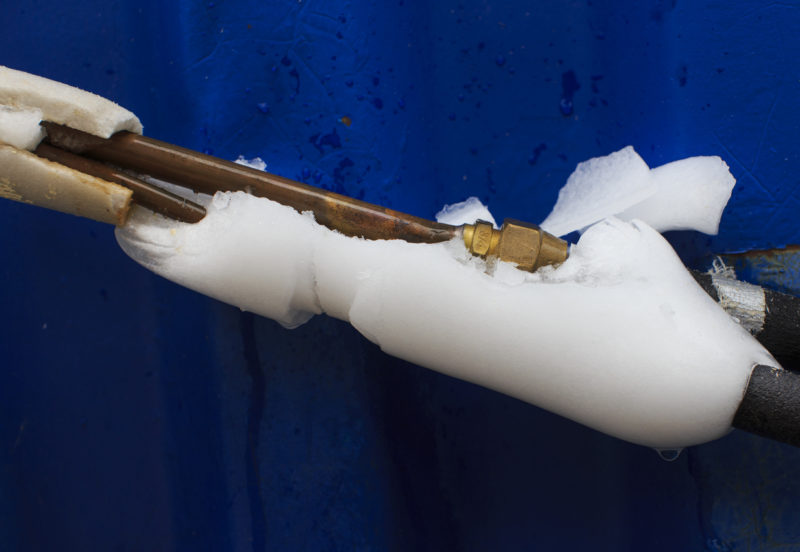What to I Do If My AC Pipe Is Frozen? - Essential Tips for Restoring Functionality
What to I Do If My AC Pipe Is Frozen? - Essential Tips for Restoring Functionality
Blog Article
Have you been on the lookout for information and facts concerning Air Conditioner Frozen? How To Fix your Frozen AC Line?

Intro
Uncovering that your AC pipe is frozen can be worrying, specifically throughout warm summertime when you rely upon your a/c the most. Recognizing what to do in such a situation is vital to stop more damages to your air conditioning system and guarantee your comfort indoors.
Recognizing the Causes
A number of factors can contribute to the freezing of an air conditioning pipe. Recognizing these reasons can assist you resolve the concern properly.
Lack of Airflow
One usual source of an icy a/c pipe is inadequate airflow. When the air flow over the evaporator coil is restricted, it can cause the coil to go down below freezing temperature, resulting in ice development on the pipe.
Reduced Refrigerant Levels
Insufficient cooling agent levels in your air conditioning system can additionally cause an icy pipe. Reduced cooling agent levels can create the pressure in the system to go down, leading to the freezing of moisture on the evaporator coil.
Winter Conditions
In cooler environments, freezing temperatures outside can contribute to the freezing of a/c pipelines. If your air conditioner device is not properly insulated or if there are leaks in the ductwork, cold air can infiltrate the system, causing the pipe to ice up.
Dirty Air Filters
Unclean or blocked air filters can limit air flow in your a/c system, causing different issues, including an icy pipeline. It's important to replace or clean your air filterings system frequently to guarantee proper air movement and stop ice buildup.
Signs of a Frozen Air Conditioner Pipe
Acknowledging the signs of an icy air conditioning pipeline is important for timely activity.
Decreased Airflow
If you see a considerable decline in air flow from your vents, it can indicate an icy pipeline.
Ice Buildup on the Pipe
Visible ice build-up on the refrigerant line or the evaporator coil is a clear sign of an icy air conditioner pipeline.
Weird Sounds from the Unit
Uncommon noises, such as hissing or bubbling, originating from your air conditioning system can indicate that there's ice existing on the pipe.
Immediate Actions to Take
When confronted with a frozen air conditioning pipe, it's vital to act quickly to prevent further damages to your air conditioning system.
Shutting off the a/c
The primary step is to switch off your ac system to prevent the system from running and aggravating the problem.
Checking for Blockages
Inspect the location around the indoor device for any blockages that might be blocking air movement, such as furniture or drapes.
Defrosting the Pipe
You can utilize mild techniques like positioning towels soaked in warm water around the frozen pipeline to help thaw it slowly.
Safety nets
Taking safety nets can assist stay clear of future occurrences of a frozen a/c pipeline.
When DIY Methods Fail
If your attempts to thaw the pipeline or address various other issues are unsuccessful, it's time to contact a specialist.
Value of Hiring a Professional HVAC Technician
A licensed HVAC technician has the knowledge and tools necessary to detect and repair concerns with your air conditioning system safely and successfully.
Routine Maintenance Checks
Schedule routine upkeep contact a professional HVAC service technician to guarantee that your a/c system is running efficiently.
Altering Air Filters
Regularly replace or clean your air filters to avoid air movement restrictions and keep optimum performance.
Insulating Exposed Pipes
If your air conditioner pipes are revealed to cool temperatures, take into consideration insulating them to avoid cold during cold weather.
Seeking Professional Help
If DIY techniques fall short to deal with the problem or if you're unsure regarding just how to continue, it's best to seek support from a qualified HVAC service technician.
Verdict
Dealing with a frozen air conditioner pipeline can be a frustrating experience, but knowing how to respond can aid decrease damages and recover convenience to your home. By recognizing the reasons, acknowledging the indications, and taking prompt action, you can properly resolve the problem and avoid future occurrences.
What to Do If Your AC Line Is Frozen
Make Sure All Supply and Return Air Vents Are Open
If you notice problems with airflow, the first thing you should do is check your supply and return vents. Supply vents distribute clean, conditioned air throughout your home. As this air becomes stale, it’s pulled into the return vent, where it’s reconditioned before being sent back out through the supply vent.
When these vents are closed, air won’t flow in the home. Before examining your AC, check the vents in every room and ensure they’re all open.
Check for a Dirty Air Filter
Another possible cause of limited airflow is a dirty air filter. Your air conditioner’s filters catch elements you don’t want to breathe in, such as dirt and dust. Over time, filters can become clogged, ultimately blocking air from flowing in and out. The lack of airflow can then cause the entire coil to freeze and will completely restrict any air from moving through it. The AC may need to be powered off for one to two days to allow the coil to thaw after replacing the filter to allow proper functioning of the unit. This debris can also accumulate on your AC’s evaporator coil, requiring a more serious repair. In general, air filters should be cleaned regularly (about every two weeks).
Assess Your Outdoor Unit
In addition to checking your AC, assessing the outdoor unit is a good idea. Also known as the condensing unit, it works with your interior unit to release heat outside. An issue with the outdoor unit can result in rising internal temperatures.
Overgrown Shrubs or Clogged Leaves
From leaves and twigs to shrubs and debris, there’s no shortage of outdoor elements that can accumulate around your condensing unit. When these elements get lodged inside the unit, they can block airflow. Fortunately, removing the blockage can solve the problem.
Sounds of a Broken Fan
Shrubs and leaves aren’t the only things that can impede your outdoor unit’s airflow. If the fan is broken, the unit won’t be able to properly get rid of heat — which means the internal temperature won’t go down. First, make sure the fan is spinning. If it is, check for the following sounds of a broken fan:
Buzzing Rattling Screeching Hissing Clicking Preventative Measures
Nobody wants to deal with a frozen AC line. In addition to causing problems with your air conditioner, they require professional repairs. On the bright side, there are preventative measures you can take to help ensure this issue doesn’t arise in the first place.
https://www.coopergreenteam.com/blog/what-to-do-if-ac-line-frozen

I'm very fascinated by Why Is Ice On My Outside Air Conditione and I am hoping you enjoyed the entire article. I beg you set aside a second to promote this entry if you appreciated it. I love reading our article about What Do I Do If My AC Pipe Is Frozen.
Suggested Site Report this page